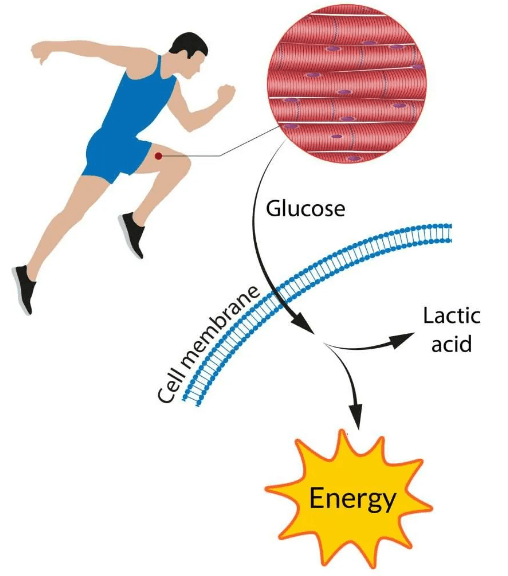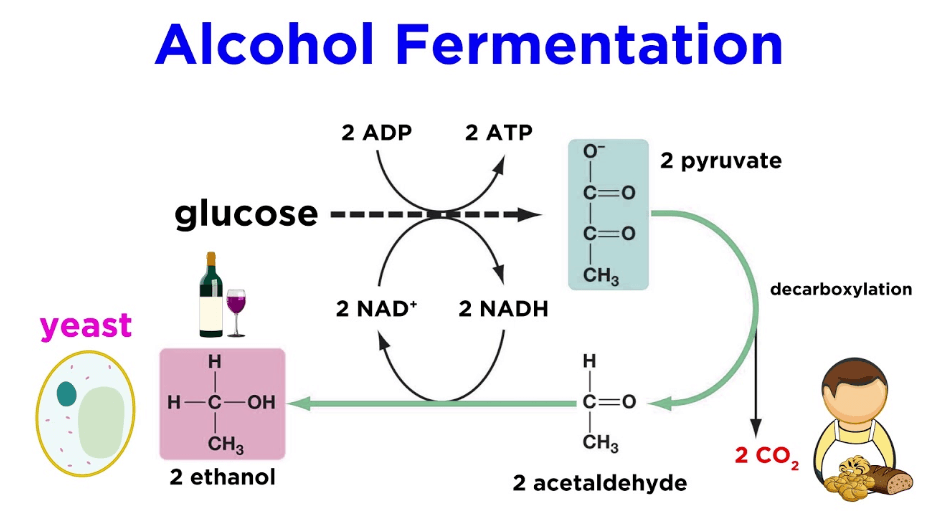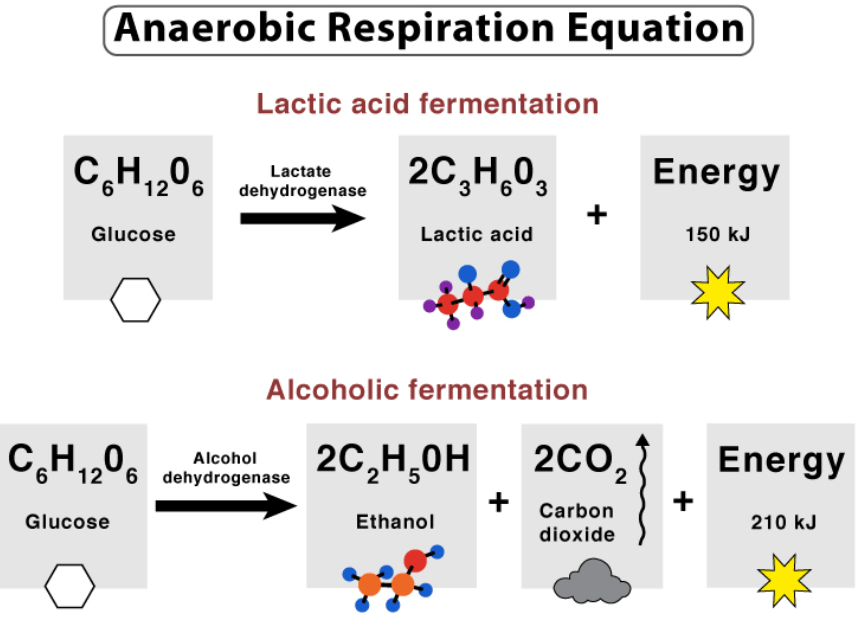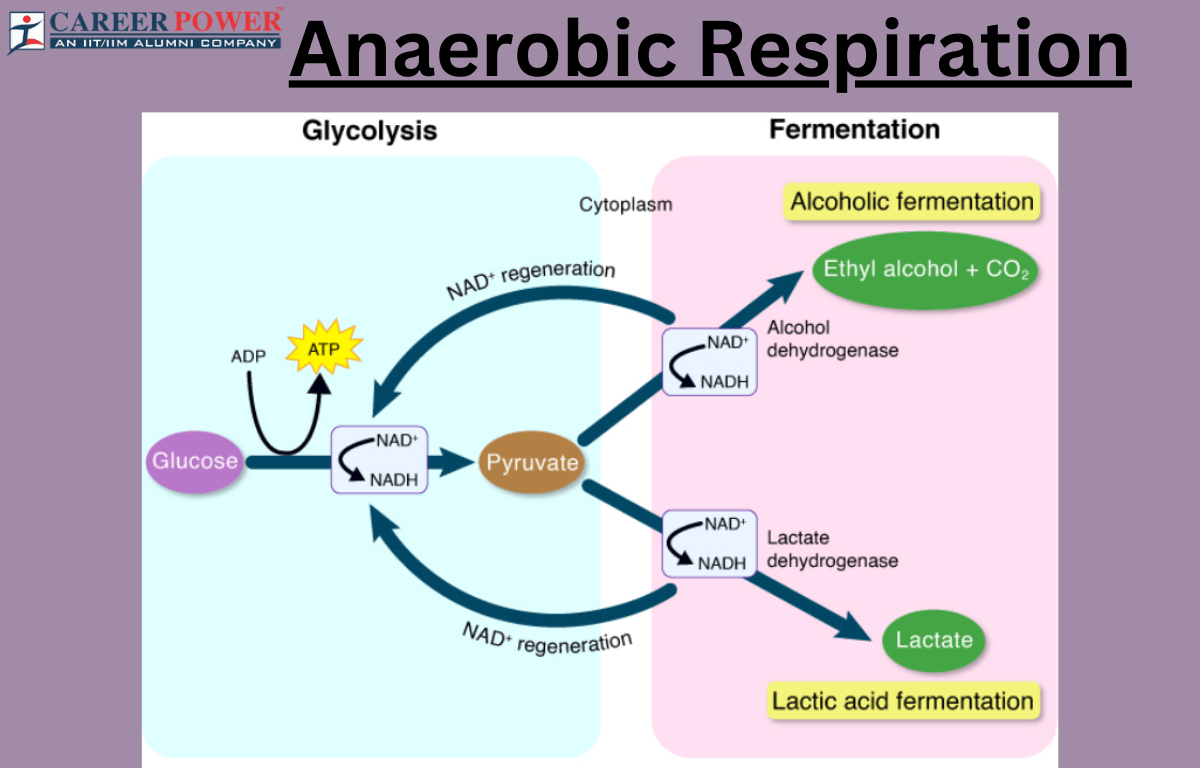As we know respiration is a fundamental process in Biology by which living organisms extract energy from nutrients to sustain life. Respiration can be of two types: Aerobic respiration and Anaerobic respiration. Aerobic preparation occurs in the presence of oxygen while anaerobic respiration takes place in the absence of oxygen. Both types of respiration involve the breakdown of glucose to produce energy, but they differ in terms of efficiency and end products.
Definition of Anaerobic Respiration
Anaerobic respiration is a metabolic process that occurs in the absence of oxygen. Anaerobic respiration is less efficient than Aerobic Respiration but allows cells to produce energy when oxygen levels are low. One common type of anaerobic respiration is lactic acid Fermentation in muscles, which produces lactic acid as a byproduct. Another type is alcoholic fermentation, seen in yeast and some bacteria, which produces ethanol and carbon dioxide.
Types of Anaerobic Respiration
There are mainly two types of anaerobic respiration, namely: Lactic acid fermentation and Alcoholic fermentation; each associated with different products. These two types of anaerobic respiration allow organisms to generate ATP and continue metabolic processes in the absence of oxygen, although they are less efficient than aerobic respiration in terms of ATP production per glucose molecule.
| Types of Anaerobic Respiration | |||
| Types | Organisms | End Products | Occurrence |
| Lactic Acid Fermentation | Animal cells, and some bacteria. | The end product formed during this process is lactic acid. | Lactic acid fermentation occurs in the muscle cells during intense physical activity & it also takes place in some bacteria in low-oxygen environments. |
| Alcoholic Fermentation | Yeast, some bacteria, and fungi. | The end products formed during alcoholic fermentation are Ethanol (alcohol) and carbon dioxide (CO2). | Occurs in yeast during the fermentation of sugars (e.g., in beer and wine production) & is also used in breadmaking to leaven the dough. |
Lactic Acid Fermentation
The lactic acid fermentation is a metabolic process that occurs during anaerobic respiration. Lactic acid fermentation is a survival mechanism that allows cells to maintain energy production in the absence of sufficient oxygen, although it is less efficient than aerobic respiration.

- Lactic acid fermentation is commonly observed in animal cells, including human muscle cells, and certain types of bacteria.
- The primary end product of lactic acid fermentation is lactic acid (lactate).
- During intense physical activity, when the oxygen supply cannot meet the energy demands of muscle cells, they switch to lactic acid fermentation. This process helps generate ATP (energy) to sustain muscle contractions.
- Accumulation of lactic acid in muscle in muscle cells can lead to muscle fatigue and soreness, which is often experienced after strenuous exercise.
- Lactic acid fermentation provides a temporary source of energy when oxygen availability is limited. It allows cells to continue functioning until oxygen becomes available again.
- Lactic acid fermentation is also used in the production of certain dairy products like yogurt and cheese, where bacteria convert lactose (milk sugar) into lactic acid, contributing to the product’s flavor and texture.
Alcoholic Fermentation
Alcoholic fermentation is a metabolic process that occurs during anaerobic respiration. Alcoholic respiration plays a significant role in both culinary and industrial processes, and it showcases how organisms can adapt to generate energy when oxygen is not readily available. Here are some key points about alcoholic fermentation:

- Alcoholic Fermentation is primarily associated with yeast cells, although some types of bacteria and fungi can also carry out this process.
- The end products of alcoholic fermentation are ethanol (alcohol) and carbon dioxide (CO2).
- Yeast cells use alcoholic fermentation when they lack access to oxygen. This process is commonly employed in the production of alcoholic beverages like beer and wine.
- During alcoholic fermentation, yeast cells convert (such as glucose and maltose) into ethanol and carbon dioxide. This process gives rise to the alcohol content and effervescence in beverages.
- Beyond food and beverage production, alcoholic fermentation is used in various industrial processes, such as the production of biofuels like ethanol, which can be used as an alternative fuel source.
- Like lactic acid fermentation, alcoholic fermentation is a way for cells to generate energy (in the form of ATP) when oxygen is scarce, It is less efficient in terms of ATP production compared to aerobic respiration but allows cells to continue functioning in a low-oxygen environment.
Examples of Anaerobic Respiration
Here we have discussed some of the examples that illustrate the versatility of anaerobic respiration across different organisms and ecological niches, allowing them to adapt and generate energy in environments where oxygen availability is limited.
- Human Muscle Cells: During intense physical activity, when oxygen demand exceeds supply, human muscle cells switch to anaerobic respiration, primarily lactic acid fermentation. This allows muscles to continue contracting and producing energy even in the absence of sufficient oxygen.
- Yeast: Yeast cells undergo alcoholic fermentation in the absence of oxygen. This process is harnessed in the production of alcoholic beverages like beer and wine, where yeast converts sugars into ethanol and carbon dioxide.
- Bacteria in the Gut: Some types of bacteria in the Human Digestive System carry out anaerobic respiration. For example. certain species of gut bacteria help break down complex carbohydrates and produce gases like methane and hydrogen through anaerobic fermentation.
- Biomass Production: In biogas digesters, microorganisms break down organic materials (such as agricultural waste or savage) anaerobically, producing biogas composed primarily of methane and carbon dioxide. This biogas can be used for heating or electricity generation.
- Deep-Sea Environment: Anaerobic respiration is prevalent in the deep sea where oxygen levels are extremely low. Microorganisms in these environments utilize alternative electron acceptors, such as sulfur compounds, to carry out anaerobic metabolism.
Chemical Equation of Anaerobic Respiration
In anaerobic respiration, glucose is partially broken down without the use of oxygen, leading to the production of ethanol and carbon dioxide as waste products. This process is less efficient in terms of energy production compared to aerobic respiration, which fully oxidizes glucose to produce more ATP (adenosine triphosphate). The chemical equation for anaerobic respiration in humans, where glucose is the primary substrate, can be represented as follows:
C6H12O6 (Glucose) → 2C3H6O3 (Lactic Acid) + Energy
In yeast, the chemical equation for anaerobic respiration, also known as fermentation, typically involves the conversion of glucose into ethanol and carbon dioxide. Yeast cells use this anaerobic process when oxygen is not readily available to generate energy from glucose. This fermentation process is commonly used in baking and brewing industries, where yeast is responsible for making dough and producing alcohol.
C6H12O6 (Glucose) → 2C2H5OH (Ethanol) + 2CO2 (Carbon dioxide) + Energy

Process of Anaerobic Respiration
Anaerobic respiration, often referred to as fermentation, involves several steps to generate energy in the absence of oxygen. It is an essential process in organisms that can thrive in environments with low oxygen levels or during intense, short bursts of activity (like sprinting in humans). It allows them to generate energy even when oxygen is scarce.
Step 1: Glycolysis
This is the initial step of both aerobic and anaerobic respiration. In glycolysis, one glucose (a sic-carbon sugar) is broken down into two molecules of pyruvate (a three-carbon compound). This process occurs in the cytoplasm of the cell and produces a small amount of ATP and NADH.
Step 2: Fermentation
In the absence of oxygen, pyruvate generated in glycolysis is directed towards fermentation pathways. The specific type of fermentation can vary depending on the organism.
Step 3: Regeneration of NAD+
During fermentation, an essential role is played by the regeneration of NAD+. This is necessary to keep glycolysis running because glycolysis requires NAD+ to continue. In lactic acid fermentation, NAD+ is regenerated when pyruvate is reduced to lactic acid. In alcohol fermentation, NAD+ is regenerated as pyruvate is converted into ethanol.
Step 4: Energy Production
While anaerobic respiration generates much less ATP than aerobic respiration, it still produces a small amount of energy in the form of ATP during glycolysis. This ATP can be used for cellular functions.
Let us learn more about anaerobic respiration
Below we have discussed some more interesting points about anaerobic respiration:
- Energy Production: Anaerobic respiration is a way for cells to produce energy (in the form of ATP) without using oxygen as the final electron acceptor in the electron transport chain, as in aerobic respiration.
- Efficiency: Anaerobic respiration is less efficient in terms of ATP production compared to aerobic respiration. Aerobic respiration generates more ATP per glucose molecule because oxygen is a highly efficient electron acceptor.
- End Products: The end products of anaerobic respiration (lactic acid or ethanol) can be toxic if they accumulate in large quantities, which is why cells typically switch back to aerobic respiration once oxygen becomes available.
- Importance: Anaerobic respiration is essential in situations where oxygen supply is limited or during short bursts of intense activity when oxygen demand exceeds supply. It helps cells maintain energy production even in less-than-ideal conditions.



 50 Vegetables Name for Kids in English a...
50 Vegetables Name for Kids in English a...
 Food Chain: Definition, Types, Examples,...
Food Chain: Definition, Types, Examples,...
 Human Respiratory System: Definition, Di...
Human Respiratory System: Definition, Di...













